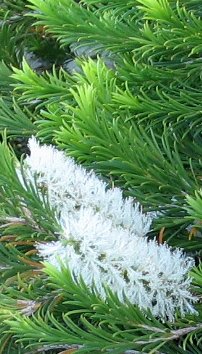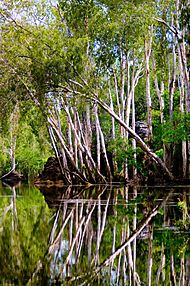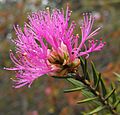Melaleuca facts for kids
Quick facts for kids Melaleuca |
|
|---|---|
 |
|
| M. armillaris foliage and flowers | |
| Scientific classification |
|
| Kingdom: | Plantae |
| Clade: | Tracheophytes |
| Clade: | Angiosperms |
| Clade: | Eudicots |
| Clade: | Rosids |
| Order: | Myrtales |
| Family: | Myrtaceae |
| Subfamily: | Myrtoideae |
| Tribe: | Melaleuceae |
| Genus: | Melaleuca L. |
| Species | |
| Synonyms | |
|
Genus synonymy
Baudinia Lesch. ex DC.
Beaufortia R.Br. in W.T.Aiton Billottia Colla Callistemon R.Br. Calothamnus Labill. Conothamnus Lindl. Eremaea Lindl. Eremaeopsis Kuntze Gymnagathis Schauer Kajuputi Adans. nom. rej. Lamarkea Rchb. orth. var. Lamarchea Gaudich. Manglesia Lindl. Meladendron St.-Lag. Melaleucon St.-Lag. orth. var. Melanoleuce St.-Lag. orth. var. Ozandra Raf. Petraeomyrtus Craven Phymatocarpus F.Muell. Regelia Schauer Schizopleura Endl. Trichobasis Turcz. nom. illeg. |
|
Melaleuca is a group of nearly 300 different plant species. These plants belong to the myrtle family, called Myrtaceae. People often call them paperbarks, honey-myrtles, or tea-trees. However, the name "tea-tree" is also used for other plants like Leptospermum.
Melaleucas can be small shrubs, growing less than 1 meter (3 feet) tall. They can also be large trees, reaching up to 35 meters (115 feet) high. Their flowers usually grow in groups, forming a "head" or "spike." These flower clusters often look like a bottle brush. Each cluster can have up to 80 individual flowers.
Melaleucas are very important for nature. They provide food for insects, birds, and mammals that eat nectar. Many melaleucas are popular garden plants because of their pretty flowers. Some are grown to create dense screens or hedges. A few species are used to make fences or valuable oils like "tea tree" oil.
Most melaleucas are found only in Australia. Some also grow in places like Malesia (Southeast Asia and New Guinea). Seven species are found only in New Caledonia. One species lives only on Lord Howe Island in Australia. Melaleucas grow in many different places. Some live in swamps and wet areas. Others grow in sandy soils or near salty lands. While some are common, others are quite rare and in danger. Things like clearing land, draining swamps, and a plant disease called myrtle rust threaten many melaleuca species.
Contents
What Melaleuca Plants Look Like
Melaleuca plants come in many sizes. Some are small shrubs, like M. aspalathoides, which are less than 1 meter (3 feet) tall. Others are tall trees, such as M. cajuputi and M. quinquenervia. These trees can grow up to 35 meters (115 feet) high. One M. cajuputi tree was even measured at 46 meters (151 feet)!
Many melaleucas, like M. lineariifolia, are called paperbarks. This is because their bark peels off in thin, papery sheets. About 20% of melaleuca species, including M. bracteata, have hard, rough bark. Another 20% have bark that feels like fibers. All melaleuca species are evergreen, meaning they keep their leaves all year. Their leaves vary a lot in size. Some are tiny, like scales (M. micromera). Others can be very long, up to 270 millimeters (11 inches) (M. leucadendra). Most melaleuca leaves have small oil glands. These glands make the leaves smell nice, especially when you crush them.
Melaleuca Flowers
Melaleuca flowers usually grow in spikes or heads. Within these clusters, flowers often appear in groups of two or three. Each flower or group has a papery leaf-like part called a bract at its base. There are five sepals, which are small leaf-like parts that protect the flower bud. Sometimes these sepals are joined together in a ring. There are also five petals, which are usually small and not very showy. They often fall off soon after the flower opens.
The stamens are the parts that produce pollen. They come in many colors, like white, cream, yellow, red, or purple. The yellow tips of the stamens (called anthers) stand out against their "stalks" (called filaments).
Melaleuca Fruit and Seeds
After flowering, melaleucas produce woody fruits. These fruits are like small, hard capsules. They can be cup-shaped, barrel-shaped, or almost round. Often, they grow in clusters along the stems. The seeds inside these fruits can stay there for many years. They only open and release the seeds when the plant, or part of it, dies. This also happens when the plant is heated by a bushfire. In tropical areas, the seeds are released every year during the wet season.
How Melaleuca Got Its Name
The first known description of a Melaleuca plant was written in 1741 by Georg Eberhard Rumphius. He called the plant Arbor alba, which means "white tree." Today, we know this plant as Melaleuca leucadendra. The name Melaleuca was first officially used by Carl Linnaeus in 1767. Many plants that were once called Metrosideros were then moved into the Melaleuca group. In Australia, Melaleuca is the third largest group of plants, with almost 300 species.
The name Melaleuca comes from two Ancient Greek words. "Mélas" means "dark" or "black," and "leukós" means "white." This name likely came about because one of the first plants described had white bark that was blackened by fire.
The common name "tea-tree" is used for several plant groups, including Leptospermum, Melaleuca, Kunzea, and Baeckea. This name came from Captain James Cook's voyage to Australia in 1770. His sailors on the Endeavour used the leaves of a shrub from one of these groups to make a drink. It was a replacement for regular tea (Camellia sinensis).
Where Melaleucas Grow
Most melaleucas grow naturally only on the Australian mainland. Eight species are found in Tasmania, but only two of them grow only on that island. One species, M. howeana, is found only on Lord Howe Island. Seven species are found only on Grande Terre, the main island of New Caledonia.
A few tropical species also grow in Papua New Guinea. One type of Melaleuca cajuputi even grows as far north as Myanmar, Thailand, and Vietnam. The southwest part of Western Australia has the most different kinds of melaleuca species. In the tropical north of Australia, species like M. argentea and M. leucadendra are very common and cover large areas.
Melaleucas can grow in many different types of soil. Many can even handle being in water, sometimes all the time. Some species, like the South Australian swamp paperbark (M. halmaturorum), grow well in salty soils. Few other plants can survive in such conditions. Many melaleucas can survive fires. They regrow from special buds (epicormic buds) or by growing new shoots from their base (coppicing). However, you won't find melaleucas in rainforests. Also, very few species grow in dry, desert-like areas.
Melaleuca Ecology
Melaleuca plants are mostly pollinated by insects. These include the common honey bee (Apis mellifera), flies, beetles, wasps, and thrips. Birds like lorikeets and honeyeaters often visit the flowers. Bats also visit them. These animals likely help to pollinate the flowers too.
Some melaleuca species, especially M. alternifolia, are grown to make tea tree oil. In large farms, these plants can be attacked by insect pests. The most damaging is a Chrysomelid beetle called Paropsisterna tigrina. Other beetles, caterpillars (Agrotis species), psyllids, and mole crickets can also cause a lot of damage. More than 100 types of insects are known to eat melaleucas. Wild melaleuca plants have fewer pests. But tea tree sawfly (Pterygophorus species) and longicorn beetles are often found on them.
Melaleucas can also get a disease called myrtle rust (Puccinia psidii). This rust can harm soft plant parts and even kill plants that are very sensitive to it. Myrtle rust is common in eastern Australia, including Tasmania. It has also been found in the Tiwi Islands.
Invasive Melaleuca Species
Melaleuca quinquenervia (broad-leaved paperbark) is a big problem in the Florida Everglades in the United States. It was brought there in the early 1900s to help drain wet, swampy areas. But it has become a serious invasive species. This means it spreads quickly and harms the local environment. It pushes out native plants and animals. It also changes how water flows, affects the soil, and changes how fires behave in the area.
How People Use Melaleuca
Traditional Aboriginal Uses
Aboriginal Australians used several types of Melaleuca plants. They made rafts from the bark. They also used the bark for roofing their shelters. The bark was even used for bandages and for preparing food. In the Northern Territory, "bee bread" and honey were collected from the hives of native stingless bees in melaleuca forests. The Bundjalung people lived in an area of north-eastern New South Wales where Melaleuca alternifolia grows naturally. They treated skin infections by crushing the leaves of this plant. Then they would cover the area with a warm mudpack.
Special Oils from Melaleuca
Melaleuca alternifolia is famous for its essential oil, known as tea tree oil. This oil can fight both fungi and bacteria. It can be safely used on the skin. This oil is made in large amounts and sold commercially.
Melaleuca cajuputi is used to make a similar oil called cajuput oil. This oil is used in Southeast Asia to treat different infections. It is also used to add scent to food and soaps.
Melaleuca in Gardens
Melaleucas are popular garden plants. You can find them in Australia and other tropical places around the world. The first melaleucas grown in gardens were from seeds planted in England in 1771. Some melaleucas are commonly grown as trees for parks and big gardens, like Melaleuca leucadendra. Others are grown as ornamental plants, sometimes called Callistemon. Examples include M. citrina (also known as Callistemon citrinus), M. hypericifolia, and M. wilsonii.
Melaleucas Used in Gardens
-
M. pulchella ("claw flower") in Melbourne Botanic Garden
-
M. squarrosa in Langwarrin Flora and Fauna Reserve
-
M. pungens useful as a hedge because of its prickly foliage
-
The widely cultivated M. hypericifolia in Arthurs Seat State Park
-
M. salicina - a popular garden shrub
-
M. linariifolia (snow-in-summer).
See also
 In Spanish: Melaleuca para niños
In Spanish: Melaleuca para niños











